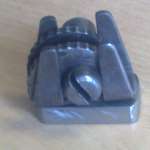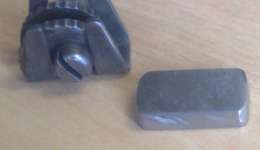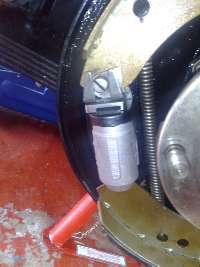The MGA With An Attitude
New Brake SHOES DON'T FIT - BT-102
At 09:55 PM 8/10/04 -0400, Mike Carnell wrote:
>"The previous owner had put new brake shoes on the car and now I can just barely get the drum off."
Been there. Apparently there are manufacturing differences in various brands of brake shoes. Most notably the thickness of the friction lining varies considerably. Apparently there are also some small variations in the shape of the steel shoes, particularly in the area of the abutment stops and where the cylinder pushes.
Some shoes are such a loose fit that the adjuster is mostly extended when the shoes are new, and the adjuster may be useless when the linings are half worn. Resurfacing the brake drums enlarges the ID and aggravates the situation some. Others may be so tight that the drum is hard to install (or remove), even with the adjuster set to minimum.
The final solution may be to buy a different brand of brake shoes.
>"When I finally got the drum off, I could see a lot of oily dust and the cylinders were rusty. I thought it might be that the cylinders had seized in a somewhat open position,"
That might only happen on the rear if the hand brake had been set for a long time in storage.
>"so I bit the bullet and put in all new cylinders. No change."
Yeah, it figures.
>"The weird thing about this problem is that the right front also has new shoes yet the drum goes on with only a slight touching."
Perhaps the drum has been turned once, making it slightly larger. Drums are expensive these days. I would not advise turning the drums just for the purpose of enlarging them to accommodate the overstuffed shoes. There are brake shops with a jig fixture disk sanding setup that can grind the shoes down to the correct radius to match the drums. When I had new brakes installed on my first MGA back in 1968 it was standard practice to turn the drums first (if needed), then measure the finished diameter and grind the shoes to match the radius. Doing that, the break in period is just about zero. First time you step on the pedal you have good solid brakes.
But I haven't paid a pro shop to do brakes on my cars for decades, so I can't swear they even do that any more. Like wheel balancing is now all spin balancing, because any monkey can be trained in a minute or two, where static balancing requires 10 minutes to train an average monkey, and the common cheap wrench may never get it. So maybe the pro shops don't grind shoes any more either for the same reason.
>"The shoes are the same on both wheels, everything else appears to be the same. I'm stumped!!! Short of sanding off some of the lining (just kidding) I don't know where to go from here."
In a pinch, when the shoes are too tight, I suggest you grind a smidge off of the steel web of the shoe at the contact points with the anchor block and the cylinder.
Addendum, August 2009:

 The flip side of this brake shoe fitting issue is shoes that fit so loose that the adjuster runs out of travel before the shoes are snug up to the drums. Pictures here are supplied by Vin Rafter in South Yorkshire, UK. His solution was to tack weld a 5-mm thick steel pad to the adjuster mask to raise the adjuster and take up the excess space.
The flip side of this brake shoe fitting issue is shoes that fit so loose that the adjuster runs out of travel before the shoes are snug up to the drums. Pictures here are supplied by Vin Rafter in South Yorkshire, UK. His solution was to tack weld a 5-mm thick steel pad to the adjuster mask to raise the adjuster and take up the excess space.


I only ran into the problem of "loose" brake shoes once, about 15 years ago. I then bought brake shoes from a different supplier, and have never seen the problem since. At the time I never bothered to investigate the cause of the problem. Maybe the old problem has come back to haunt us again (or maybe not). Before we jump in with both feet to blame the suppliers we should figure out what the problem really is. You should start by measuring the lining thickness. I currently have in my possession two brands of brake shoes, Lockheed with riveted linings and ABS with bonded linings. They are both 3/16-inch thick (0.180-0.190), and they both fit and work okay.
If your linings are 3/16" thick, and you still have the problem, then measure inside diameter of the brake drums. Those should be 10-inches (10.000") diameter (originally). Circumference equals PI x Dia. It is common to allow 0.030" oversize for turning the drums. They are however sometimes found to be up to 0.060" oversize (10.060" ID). In this case 0.060" x 3.1416 = 0.188" increase of circumference, which is getting very close to the 5-mm thickness of Vin's tack welded build-up pad. So 0.060" oversize drums will definitely cause that problem.
Incidentally, linings worn just 1/32" (0.030") on the radius will also get to the same point on the adjuster, so there is not much latitude for turning the drums oversize. With oversize drums you have to change the brake shoes more often. This is less of a problem on the front drum brakes where you have two adjusters.
Addendum, June 30, 2018:
I have now been bitten by this problem too many times. Brake shoes I have been buying from Moss Motors for the past few years have always been undersize. Using good brake drums (10.00" inside diameter), when the new shoes are installed the MGA adjusters go all the way to end of adjustment range before the brakes are serviceable. Rear brakes are still a little loose. Front brakes are on one of the last two notches of the adjuster when properly adjusted the first time. The brakes cease to be functional when the linings are about 30% worn and cannot be adjusted again. This is a worse problem for rear brakes that have only one adjuster cam. I last replaced my rear shoes on 3/25/18 with 00,744 miles showing on the odometer. Today it has 07,732 on the odometer, and the parking brake is just about useless when the shoes cannot be adjusted (after only three months use on the new brake shoes). I can't be buying new brake shoes every few months because Moss is supplying parts unfit for the application, so I will now have to find a different supplier for these parts.
See Faulty Parts Report on brake shoes that are too small FT-094
Addendum May 4, 2022:
Not sure the addition of a fat O-ring will solve the problem of too-small brake shoes, but George McNichol has the following suggestions.
 "I personally have never tested or experienced brake shoes too small. The only way to accurately measure the height of a brake shoe is on a flat surface, with the adjuster on the table with the shoe installed and adjusted to the lowest setting. Then do the same test with a known good brake shoe. I feel the following is a better solution to rectifying the problem than Welding extension on the brake shoes or welding a shim on the brake adjuster. "I personally have never tested or experienced brake shoes too small. The only way to accurately measure the height of a brake shoe is on a flat surface, with the adjuster on the table with the shoe installed and adjusted to the lowest setting. Then do the same test with a known good brake shoe. I feel the following is a better solution to rectifying the problem than Welding extension on the brake shoes or welding a shim on the brake adjuster.
 I worked at a MG dealer as a technician in the 50’s when MGAs were very popular. In those days when replacing brake shoes on MGs some of the repair kits had rubber O-rings to go under the medal wheel cylinder dust cap others did not. (We used several different vendors due to poor service from our distributor)
About 25 years ago I bought several MGA front junk wheel cylinders at Carlisle Import show. I still have one, so today I opened it up and it has an O-ring in the dust cap.
Today, whenever I’m going to pull a brake drum for any reason, I adjust the brake adjusters to the proper setting and them back it off counting the number of clicks and noting them on a piece of paper. I worked at a MG dealer as a technician in the 50’s when MGAs were very popular. In those days when replacing brake shoes on MGs some of the repair kits had rubber O-rings to go under the medal wheel cylinder dust cap others did not. (We used several different vendors due to poor service from our distributor)
About 25 years ago I bought several MGA front junk wheel cylinders at Carlisle Import show. I still have one, so today I opened it up and it has an O-ring in the dust cap.
Today, whenever I’m going to pull a brake drum for any reason, I adjust the brake adjusters to the proper setting and them back it off counting the number of clicks and noting them on a piece of paper.
 When reinstalling the drum, I add a rubber O-ring under the dust cover after I remove any old O-ring. (I use a sharp ice pick as the old one will be hard as glass)
I buy my O-rings from the local ACE hardware store as they seem to be all under $1.00 each. (O-ring # is universal to all brands of O-rings) The brand that ACE sells is Danco Inc. When reinstalling the drum, I add a rubber O-ring under the dust cover after I remove any old O-ring. (I use a sharp ice pick as the old one will be hard as glass)
I buy my O-rings from the local ACE hardware store as they seem to be all under $1.00 each. (O-ring # is universal to all brands of O-rings) The brand that ACE sells is Danco Inc.
 I never install wheel cylinder dust cap with no O-ring. I never install wheel cylinder dust cap with no O-ring.
Adding a O-ring or using a thicker one will reduce the amount of clicks required.
Here is list of O-rings that I keep on hand:
FRONT REAR
Num. ID CS Num. ID CS
022 1 “ 1/16” 118 7/8” 3/32”
120 1 “ 3/32” 212 7/8” 1/8”
214 1 “ 1/8”
I hope this is some assistance to you when you tackle your next brake repair". -- George
|


